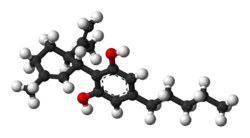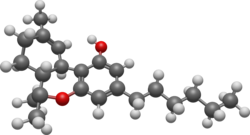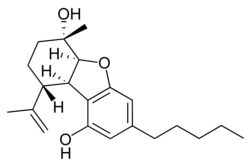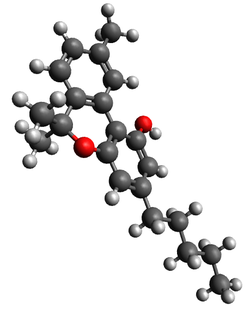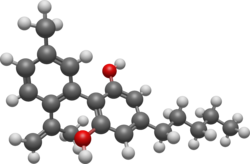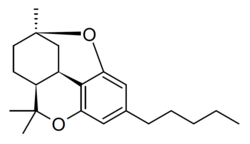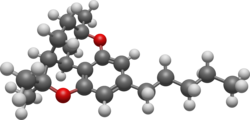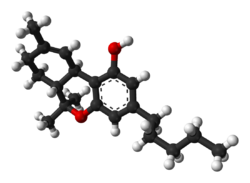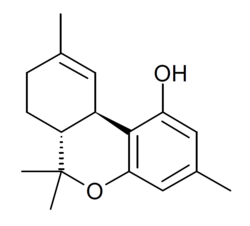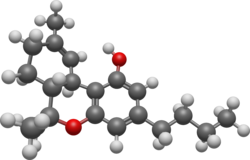| Cannabigerol-type (CBG)
|

Cannabigerol
(E)-CBG-C5
|

Cannabigerol
monomethyl ether
(E)-CBGM-C5 A
|

Cannabinerolic acid A
(Z)-CBGA-C5 A
|

Cannabigerovarin
(E)-CBGV-C3
|
|

Cannabigerolic acid A
(E)-CBGA-C5 A
|

Cannabigerolic acid A
monomethyl ether
(E)-CBGAM-C5 A
|
|

Cannabigerovarinic acid A
(E)-CBGVA-C3 A
|
|
| Cannabichromene-type (CBC)
|

(±)-Cannabichromene
CBC-C5
|

(±)-Cannabichromenic acid A
CBCA-C5 A
|

(±)-Cannabivarichromene, (±)-Cannabichromevarin
CBCV-C3
|

(±)-Cannabichromevarinic
acid A
CBCVA-C3 A
|
|
| Cannabidiol-type (CBD)
|

(−)-Cannabidiol
CBD-C5
|

Cannabidiol
momomethyl ether
CBDM-C5
|

Cannabidiol-C4
CBD-C4
|

(−)-Cannabidivarin
CBDV-C3
|

Cannabidiorcol
CBD-C1
|

Cannabidiolic acid
CBDA-C5
|
|
|

Cannabidivarinic acid
CBDVA-C3
|
|
| Cannabinodiol-type (CBND)
|

Cannabinodiol
CBND-C5
|

Cannabinodivarin
CBND-C3
|
|
|
|
| Tetrahydrocannabinol-type (THC)
|

Δ9-Tetrahydrocannabinol
Δ9-THC-C5
|
|

Δ9-Tetrahydrocannabinol-C4
Δ9-THC-C4
|

Δ9-Tetrahydrocannabivarin
Δ9-THCV-C3
|

Δ9-Tetrahydrocannabiorcol
Δ9-THCO-C1
|

Δ9-Tetrahydro-
cannabinolic acid A
Δ9-THCA-C5 A
|

Δ9-Tetrahydro-
cannabinolic acid B
Δ9-THCA-C5 B
|

Δ9-Tetrahydro-
cannabinolic acid-C4
A and/or B
Δ9-THCA-C4 A and/or B
|

Δ9-Tetrahydro-
cannabivarinic acid A
Δ9-THCVA-C3 A
|

Δ9-Tetrahydro-
cannabiorcolic acid
A and/or B
Δ9-THCOA-C1 A and/or B
|

(−)-Δ8-trans-(6aR,10aR)-
Δ8-Tetrahydrocannabinol
Δ8-THC-C5
|

(−)-Δ8-trans-(6aR,10aR)-
Tetrahydrocannabinolic
acid A
Δ8-THCA-C5 A
|

(−)-(6aS,10aR)-Δ9-
Tetrahydrocannabinol
(−)-cis-Δ9-THC-C5
|
|
|
| Cannabinol-type (CBN)
|

Cannabinol
CBN-C5
|

Cannabinol-C4
CBN-C4
|

Cannabivarin
CBN-C3
|

Cannabinol-C2
CBN-C2
|

Cannabiorcol
CBN-C1
|

Cannabinolic acid A
CBNA-C5 A
|

Cannabinol methyl ether
CBNM-C5
|
|
|
|
| Cannabitriol-type (CBT)
|

(−)-(9R,10R)-trans-
Cannabitriol
(−)-trans-CBT-C5
|

(+)-(9S,10S)-Cannabitriol
(+)-trans-CBT-C5
|

(±)-(9R,10S/9S,10R)-
Cannabitriol
(±)-cis-CBT-C5
|

(−)-(9R,10R)-trans-
10-O-Ethyl-cannabitriol
(−)-trans-CBT-OEt-C5
|

(±)-(9R,10R/9S,10S)-
Cannabitriol-C3
(±)-trans-CBT-C3
|

8,9-Dihydroxy-Δ6a(10a)-
tetrahydrocannabinol
8,9-Di-OH-CBT-C5
|

Cannabidiolic acid A
cannabitriol ester
CBDA-C5 9-OH-CBT-C5 ester
|

(−)-(6aR,9S,10S,10aR)-
9,10-Dihydroxy-
hexahydrocannabinol,
Cannabiripsol
Cannabiripsol-C5
|

(−)-6a,7,10a-Trihydroxy-
Δ9-tetrahydrocannabinol
(−)-Cannabitetrol
|

10-Oxo-Δ6a(10a)-
tetrahydrocannabinol
OTHC
|
| Cannabielsoin-type (CBE)
|

(5aS,6S,9R,9aR)-
Cannabielsoin
CBE-C5
|
|

(5aS,6S,9R,9aR)-
C3-Cannabielsoin
CBE-C3
|
|
|

(5aS,6S,9R,9aR)-
Cannabielsoic acid A
CBEA-C5 A
|

(5aS,6S,9R,9aR)-
Cannabielsoic acid B
CBEA-C5 B
|

(5aS,6S,9R,9aR)-
C3-Cannabielsoic acid B
CBEA-C3 B
|
|
|

Cannabiglendol-C3
OH-iso-HHCV-C3
|

Dehydrocannabifuran
DCBF-C5
|

Cannabifuran
CBF-C5
|
|
|
| Isocannabinoids
|

(−)-Δ7-trans-(1R,3R,6R)-
Isotetrahydrocannabinol
|

(±)-Δ7-1,2-cis-
(1R,3R,6S/1S,3S,6R)-
Isotetrahydro-
cannabivarin
|

(−)-Δ7-trans-(1R,3R,6R)-
Isotetrahydrocannabivarin
|
|
|
| Cannabicyclol-type (CBL)
|

(±)-(1aS,3aR,8bR,8cR)-
Cannabicyclol
CBL-C5
|

(±)-(1aS,3aR,8bR,8cR)-
Cannabicyclolic acid A
CBLA-C5 A
|

(±)-(1aS,3aR,8bR,8cR)-
Cannabicyclovarin
CBLV-C3
|
|
|
| Cannabicitran-type (CBT)
|

Cannabicitran
CBT-C5
|
|
|
|
|
| Cannabichromanone-type (CBCN)
|

Cannabichromanone
CBCN-C5
|

Cannabichromanone-C3
CBCN-C3
|

Cannabicoumaronone
CBCON-C5
|
|
|





